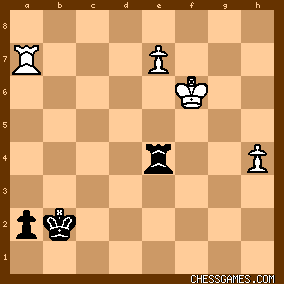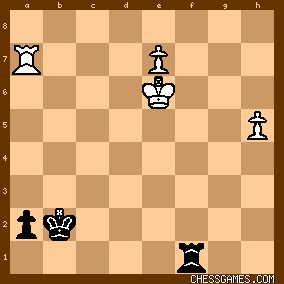| Sep-20-02 | | pawntificator: I think that 12...Qc7 was a little slow. I would have probably brought out my bishop to g4. Then if 13. Ne5 f5. Something along those lines looks more promising to me. At the very least black could have pushed that pawn to c5 without making another queen move. |
|
Sep-20-02
 | | Honza Cervenka: 12...Bg4 13.Ne5 f5 loses a pawn, for example after 14.h3, and gives field e5 to white's knight forever. After 14.h3 Bh5 15.Rb1 b6 16.Bxf5 I don't see any sufficient compensation for black. |
|
| Sep-20-02 | | pawntificator: 14. h3 Qh4... although 14. f3 would be even better I bet. |
|
Sep-20-02
 | | Honza Cervenka: 14.h3 Qh4 15.Qxb7... |
|
| Sep-21-02 | | pawntificator: OUCH. still, is Qc7 the best? |
|
Sep-23-02
 | | Honza Cervenka: I don't know if Qc7 is the best move but I don't see any significantly better move than that. I don't see any good active plan for black in this variation. Capa's attempt with c5 was evidently bad as Marshall proved in this game. |
|
| May-26-03 | | Calli: 14. c4! is an excellent move. He should have followed up with 14... dxc4 15.Bxc4! cxd4 16.Ng5 Rf8 17.exd4 with an advantage. |
|
| Jun-27-03 | | coke934: endgame here is great, if you know it your brain dont hurt as bad, if you didnt catch me i mean study all endgames, but basics, in everyone mate in 6 there s a mate in 1 so study all basics endgames and well has few hard ones, it pays trust me! |
|
| Dec-18-06 | | paladin at large: Marshall was said to be a very good endgame player but, all hands are on deck in a Capablanca endgame, especially when JRC is a pawn down. First, he breaks up the enemy's majority-side pawns, then the king mixes it up in the center with enemy pawn and rook, and Capa gets his own rook behind enemy lines and trained on every enemy pawn. And the king moves to queenside to ensure the draw. |
|
| Dec-18-06 | | who: Can someone show a win for white in some position here? |
|
| Dec-18-06 | | SatelliteDan: Doesn't 50 Rg4 win for white? |
|
| Dec-18-06 | | who: No. 50.Rg4 Rxg4! 51.hxg4 Kxe5 52.Kxf7 Kf4 53.Ke7 Kxg4 54.Kd6 Kf5 55.Kc5 Ke7 56.Kb5 Kd8 57.Kxa5 Kc8 58.Ka6 Kb8 and black just shuffles his king between a8/b8/a7 and white can never do more than stalemate. |
|
| Dec-19-06 | | who: Incidentally 50.Rg4 Kxe5 also draws because although the white king can keep the black king from getting into the a8 corner black can trap the white king in the corner in between his a pawn and the edge of the board. So it's still a draw. |
|
| Dec-19-06 | | who: Fritz thinks white could have won with 47.Rf1! Rxh3 (47...Kd5 48.Rd1+ Ke4 49.Re1+  ) 48.Re1+ Kd5 49.Kxf7 Rh7+ 50.Kg6 Re7 51.Kf6 Re6+ 52.Kf5 Re8 53.e6 Kd6 54.Rd1+ Kc6 55.Kf6 Rf8+ 56.Ke5 Re8 57.Rc1+ Kb6 58.Re1 Kc5 59.Re4 Kc6 60.Kf6 Rf8+ 61.Kg7 Ra8 62.e7 Kc5 63.e8=Q Rxe8 64.Rxe8 mate in 13. It's a pretty difficult endgame and worth studying I think. ) 48.Re1+ Kd5 49.Kxf7 Rh7+ 50.Kg6 Re7 51.Kf6 Re6+ 52.Kf5 Re8 53.e6 Kd6 54.Rd1+ Kc6 55.Kf6 Rf8+ 56.Ke5 Re8 57.Rc1+ Kb6 58.Re1 Kc5 59.Re4 Kc6 60.Kf6 Rf8+ 61.Kg7 Ra8 62.e7 Kc5 63.e8=Q Rxe8 64.Rxe8 mate in 13. It's a pretty difficult endgame and worth studying I think. |
|
| Sep-04-09 | | birthtimes: Marshall could have won with 57. h4! (time is of the essence in the endgame, passed pawns must be pushed) Rc7+ 58. Kg6 Rc6+ 59. Kh5 Rc5+ 60. Rg5! Rc8 61. Rxa5 and wins or 57...Kc3 58. Rf4 Kb3 59. Kg6 Rc6+ 60. Kg5 Rc5+ 61. Rf5! Rc8 62. Rxa5 and wins... |
|
Sep-05-09
 | | Chessical: This is the ninth game of the match played on 8th May 1909, at the Manhattan Chess Club. Hoffer in "The Field" (1909) stated: "a most difficult ending...We have, however, no doubt that White should have won it". This remains a reasonable summation of this ending, if Marshall had pushed the <h> pawn on move 46 or thereafter it is difficult to see a defence even for Capablanca. Understandable and minor inexactitudes Marshall's play (revealed by time and silicon) appears to have allowed Capablanca to draw, albeit Capablanca's play was not in itself perfect. Capablanca could have a more secure route to a draw if he had instead played: 
click for larger view<52... Rf4!?> For instance: <53. Rg7> Rxa4 54. Rxf7 Rd4+ 55. Ke7 a4 56. e6 a3 57. Kf6 a2 58. Ra7 Kb2 59. e7 Re4 60. h4 
click for larger view<60 ...Re1> (but not <60... a1=Q?> 61. Rxa1 Kxa1 62. h5 and wins) 61. h5 Rf1+ 62. Kg7 Rg1+ 63. Kf7 Rf1+ 64. Ke6= and the Rook continues to check. 
click for larger view |
|
May-31-18
 | | g15713: User <Chessical> points out that Black can draw after White plays 52.Kd6

click for larger view52...Rf4! 53.Rg7 Rxa4
54.Rxf7 and now only 54...Rd4+ draws verified by FinalGen Continuing with game continuation 52...Kg3 53.Rh4 Rf3 54.Ke7 Re3 55.Kxf7 Rxe5 we arrive with White to move at 56

click for larger viewAccording to FinalGen, a chess endgame tablebase generator for Windows, one now knows this is a win for White. Those with Lomonosov Endgame Tablebases for 7 pieces can verify this. Karsten Muller and Yakov Konoval in their eminent 2016 chess book, Understanding Rook Endgames, verified that White was winning - see pages 151 and 152 diagram 4.7.05 White should win with either 56.Rg4 or Rf4 or Rd4 |
|
Jun-01-18
 | | g15713: Correction to above: Continuing with game continuation <52...Kb3> 53.Rh4 Rf3 54.Ke7 Re3 55.Kxf7 Rxe5 |
|
Jun-15-18
 | | g15713: Going back to the previous diagram with White to move at 56
click for larger viewIt was noted that White has to free his rook with either 56.Rg4 or Rf4 or Rd4 thus White gets time to create a favorable set up with the pawn on a4 and h4 defended by the rook along the 4th rank. Please note 56.Kf6? allows Black to draw with 56...Re3! FinalGen After the game continuation 56.Rg4 Rc5 and now 57.Ke6 or h4 wins. However White played 57.Rf4? which is too slow now. Black in turn played 57...Rc7+? (57...Rc6! draws) which should have lost. White to move at 58

click for larger viewWhite could have won with either 58.Ke6 or Kf6 FinalGen After the game continuation 58.Kg6? Rb7!! draws |
|
Aug-14-18
 | | maxi: All Rook endgames are draws. |
|
| Aug-14-18 | | mjmorri: <maxi: All Rook endgames are draws.> But the converse, "All draws are Rook endgames.", is not true. |
|
Aug-14-18
 | | maxi: Your name does not happen to be NN by any chance, ha? |
|
Aug-14-18
 | | maxi: <mjmorri>..., or should I say NN? |
|





